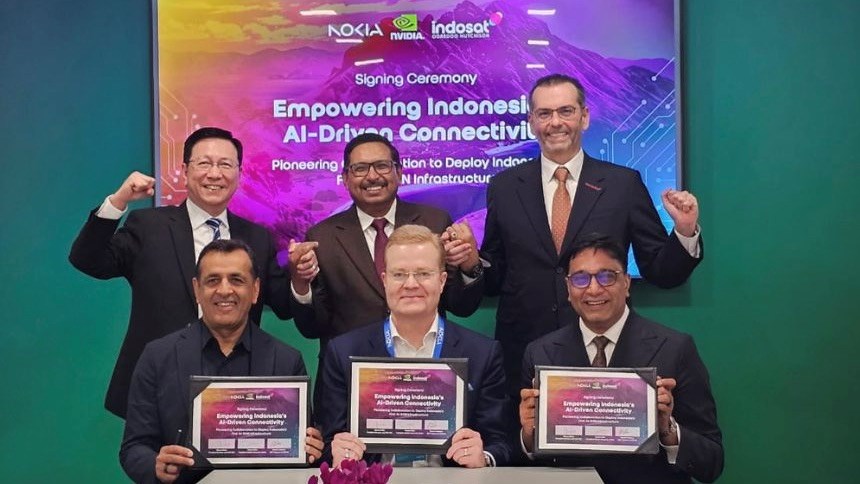
Sealing the deal (front row, left to right): Ronnie Vasishta, SVP Telecoms, Nvidia; Tommi Uitto, President, Mobile Networks, Nokia; and Vikram Sinha, CEO of Indosat Ooredoo Hutchison.
- Indosat Ooredoo Hutchison (IoH) joins the AI-RAN gang
- Telefónica trials Nokia’s 5G cloud RAN on AWS
- Airspan Networks acquires more RAN assets
In today’s industry news roundup: Indonesia’s Indosat Ooredoo Hutchison (IOH) is working with Nokia and Nvidia on its AI-RAN plans; Telefónica is working with Nokia and AWS on its cloud RAN trials in Spain; Airspan Networks follows its purchase of Corning’s small cells with the acquisition of Jabil’s radio unit portfolio; and much more!
Another telco has joined the AI-RAN club. As we reported earlier this week, Nokia highlighted its AI-RAN advances with T-Mobile US and KDDI on the eve of the MWC25 show and now the Finnish vendor has added Indosat Ooredoo Hutchison (IOH) to that list. The Indonesian operator has announced it is working with Nokia and Nvidia to deploy what it calls “a unified accelerated computing infrastructure for hosting both AI and RAN workloads”. The three companies have agreed to develop, test and deploy an AI-RAN solution with an initial focus on managing AI inference workloads using Nvidia’s AI Aerial system and then, later on, to integrate radio access network (RAN) workloads on the same platform. To support their efforts, IOH, Nokia and Nvidia will collaborate with leading Indonesian universities and research institutions to drive AI-RAN development. “This collaboration will support academic programmes to foster AI innovation in telecom applications, and provide hands-on opportunities for students and researchers to contribute to next-generation AI-powered networks. By engaging with academia, the companies aim to accelerate breakthroughs in AI-driven network optimisation, spectral efficiency and energy consumption,” noted IOH in this announcement.
Telefónica has successfully completed Europe’s first 5G standalone (SA) call using virtualised radio access network (RAN) software – Nokia’s Cloud RAN solution – running on on-premises and public-cloud architecture provided by Amazon Web Services (AWS). “Telefónica is collaborating with Nokia and AWS to bring the benefits of the cloud to next-generation 5G RAN,” noted the operator. “The three parties have evaluated and validated the hosting of Nokia Cloud RAN workloads using on-premises AWS services at Telefónica’s Madrid headquarters as well as in the AWS Region in Spain (Aragón). This hybrid architecture enables Telefónica to explore a new paradigm by leveraging the cloud continuum of AWS services that span from AWS Regions to RAN sites,” it added. The giant Spanish telco said it is currently running Nokia’s RAN Distributed Unit (DU) software in an Amazon Elastic Compute Cloud (Amazon EC2) instance powered by Graviton (an Arm-based CPU from AWS). Telefónica will work with AWS to validate AWS Outposts servers based on Graviton 3 CPU for on-premises deployment at RAN sites. In addition, the companies will continue to explore the “operational benefits of the cloud-based solution, such as Amazon Elastic Kubernetes Service (Amazon EKS) combined with Nokia’s advanced 5G network capabilities,” noted Telefónica, adding that it will also “explore simplifying the network configuration and lifecycle maintenance with common automation and observability across the network stack. José Luis Esplá, director of access and devices at Telefónica, stated: “RAN represents the final frontier for cloudification and the most critical workload for our mobile networks. Exploring the AWS cloud provides an opportunity to evolve 5G networks to achieve more flexibility and programmability by simplifying our network assets. By collaborating with thought leaders like AWS and Nokia in this domain, our goal is to validate the hybrid cloud infrastructure.”
Still with Telefónica… It has announced the creation of a Centre of Excellence dedicated to quantum technologies, which will coordinate all relevant R&D efforts from different parts of the operator, promote new solutions, strike tech partnerships and share its quantum technology proposals with the industry. “To this end, the centre will leverage the three fundamental axes of quantum technologies: Communications and cybersecurity; computing and simulation; and sensors and metrology,” noted Telefónica in this announcement. “Essentially, Telefónica aims to take advantage of the opportunities arising from quantum computing to strengthen the protection of the company’s networks and systems, as well as those of its customers, identifying the most appropriate tools and processes to reinforce their security and neutralise risks through its services. To this end, the company has begun to adopt a cryptographic agility approach in its strategy, or crypto-agility, based on enabling its systems with the necessary mechanisms to react quickly to cryptographic threats, protect keys, certificates and data, and face a future of quantum security,” it added.
Airspan Networks, the radio access network (RAN) vendor that dragged itself out of bankruptcy protection late last year with a new owner and financing, has followed up its recent purchase of Corning’s small cell business with the acquisition of Jabil’s Open RAN radio unit portfolio and associated patents for an undisclosed sum. According to Airspan, the deal includes a range of single-, dual- and triple-band macro radios and Jabil’s former radio R&D team. As a result, Airspan now claims to be “one of the most comprehensive Open RAN vendors in the market”.
Tech Mahindra has developed a multi-modal network operations large model for telcos using Nvidia’s AI Enterprise software, Meta’s Llama 3.1 8b instruct model and AWS cloud infrastructure. According to Tech Mahindra, its model is “heavily customised for telecom networks” and enables those traditional networks to become fully autonomous. Read more.
Meanwhile, global consulting and professional services firm EY has launched a suite of AI agents for telcos that was developed using a broad range of Nvidia software systems. Called the EY Telecom.ai agentic solution, the suite of tools is designed to operate across the network, finance, customer service and content lifecycle management functions of a telecom operator.
– The staff, TelecomTV
Email Newsletters
Sign up to receive TelecomTV's top news and videos, plus exclusive subscriber-only content direct to your inbox.
Subscribe